1John5918
May I begin by wishing everybody a happy and peaceful new year full of interesting bird sightings! For the last couple of years we've had a Bird of the Week thread where members have posted four favourite or interesting birds each month. Only three members actually posted birds, although the thread attracted a lot of interest from others, but we've reached the point where those three members have started running out of birds and forgetting what they have already posted! So after a brief discussion on the thread, I believe we agreed to try Bird of the Month instead of Bird of the Week. Less pressure on those who post birds, and perhaps it will encourage more members to volunteer to post, as one bird a month is a lot less daunting than four. You don't have to be an expert, and I think all of us make good use of online resources to find detailed information and photos of the birds we post.
So, let me kick off the new Bird of the Month thread in a new year with a bird which I have never actually seen, but my neighbour a few kms down the road has had them in her garden so we live in hope. The White-naped (or white-necked) raven (Corvus albicollis) is a large black raven with, as the name suggests, a white patch on the back of its neck. It has a heavy black bill with a white tip. At half a metre in length with a wingspan of over 80cm and weighing up to 860g it's slightly smaller than the common raven, but still a big bird. It's common in eastern and southern Africa and its conservation status is "Least Concern".
The White-naped raven likes open country with cliffs and mountains and can be found as low as 400m and as high as 5,800m on Mount Kilimanjaro. We live at the top of the escarpment overlooking the Great Rift Valley, at 1,900m and in sight of Kilimanjaro on a good day, so we're definitely in the sort of terrain favoured by this bird. It mainly takes food from the ground, but will also take it from trees. Diet includes carrion, fruit, grain, insects, small reptiles, groundnuts (peanuts) and human food, and they are known to forage in gardens (hence my neighbour's sighting). It has been known to drop tortoises from a height onto rocks to break their shells. The White-naped raven is found in pairs and small flocks, often in company with other scavengers such as kites and vultures, and builds its nest on cliffs or sometimes in trees.



Photos from Wikipedia and Wildlife of Kenya, with Mount Kilimanjaro's Kibo volcanic cone in the background of the last picture.
So, let me kick off the new Bird of the Month thread in a new year with a bird which I have never actually seen, but my neighbour a few kms down the road has had them in her garden so we live in hope. The White-naped (or white-necked) raven (Corvus albicollis) is a large black raven with, as the name suggests, a white patch on the back of its neck. It has a heavy black bill with a white tip. At half a metre in length with a wingspan of over 80cm and weighing up to 860g it's slightly smaller than the common raven, but still a big bird. It's common in eastern and southern Africa and its conservation status is "Least Concern".
The White-naped raven likes open country with cliffs and mountains and can be found as low as 400m and as high as 5,800m on Mount Kilimanjaro. We live at the top of the escarpment overlooking the Great Rift Valley, at 1,900m and in sight of Kilimanjaro on a good day, so we're definitely in the sort of terrain favoured by this bird. It mainly takes food from the ground, but will also take it from trees. Diet includes carrion, fruit, grain, insects, small reptiles, groundnuts (peanuts) and human food, and they are known to forage in gardens (hence my neighbour's sighting). It has been known to drop tortoises from a height onto rocks to break their shells. The White-naped raven is found in pairs and small flocks, often in company with other scavengers such as kites and vultures, and builds its nest on cliffs or sometimes in trees.



Photos from Wikipedia and Wildlife of Kenya, with Mount Kilimanjaro's Kibo volcanic cone in the background of the last picture.
2Tess_W
>1 John5918: Thanks, John! Very interesting and informative.
3NorthernStar
>1 John5918: Nice!
4John5918
NorthernStar, would you do the February Bird of the Month? And Tess, March? Unless we get any new volunteers in the coming weeks...
5Tess_W
>4 John5918: Affirmative
6elenchus
I continue to follow along, feeling a bit guilty at not volunteering (and I will continue to consider changing my mind on that) but very clear-eyed in making that decision, it's simply not something I can commit to at this point.
Very much appreciate the posts here by others, though!
Very much appreciate the posts here by others, though!
7NorthernStar
>4 John5918: Sure. If it's only one a month, I'll have to think of something really good! Or not.
9NorthernStar
For the February bird of the month I have chosen a bird that I had close encounters with many years ago when I was working in the Canadian Arctic. We were doing some geological surveys in a part of the Northwest Territories accessible only by aircraft (or a very long walk) that was north of the treeline in the open tundra. I don't think the wind ever stopped blowing. We were working in groups of two, going out from our base camp on foot to explore and map the surrounding area every day. For most of the time we were there we saw very few mammals - a fox, a few snowshoe hares, some voles or lemmings, and a place where a grizzly bear had been digging up ground squirrel burrows. What we did see was birds. There are many birds that head north to nest in the arctic, and I saw a lot that were new to me.

One of the most interesting was the Long-tailed Jaeger. These are predators related to gulls, and they nest on the tundra where they catch lemmings and raid other birds' nests to feed their young. The other 75% of the year they spend at sea, eating fish. There was one particular hill (more of a slight rise in ground - everything there was pretty flat) that we passed several times, and we think the Jaegers had a nest there, because they would come after us. The wind was strong enough that they could hang in the air at eye level, and you got the feeling that if you were any closer to the nest, they would be going for your eyes! It was like a scary game of hot and cold, as we didn't actually see the nest to avoid it.
They are a beautiful bird, with grey back, wings, and tail, creamy white breast and neck, a black cap and bill, and beautiful long feathers trailing behind.
Pictures from All About Birds: https://www.allaboutbirds.org/guide/Long-tailed_Jaeger


We were south of the pinky area that shows here as their breeding range, north of Great Slave lake by 150km or so.

One of the most interesting was the Long-tailed Jaeger. These are predators related to gulls, and they nest on the tundra where they catch lemmings and raid other birds' nests to feed their young. The other 75% of the year they spend at sea, eating fish. There was one particular hill (more of a slight rise in ground - everything there was pretty flat) that we passed several times, and we think the Jaegers had a nest there, because they would come after us. The wind was strong enough that they could hang in the air at eye level, and you got the feeling that if you were any closer to the nest, they would be going for your eyes! It was like a scary game of hot and cold, as we didn't actually see the nest to avoid it.
They are a beautiful bird, with grey back, wings, and tail, creamy white breast and neck, a black cap and bill, and beautiful long feathers trailing behind.
Pictures from All About Birds: https://www.allaboutbirds.org/guide/Long-tailed_Jaeger


We were south of the pinky area that shows here as their breeding range, north of Great Slave lake by 150km or so.
13Tess_W
March Bird of the Month
Mourning Dove
This is a very common bird in the midwest with lovely cooing sounds. We find them often early in the morning under our bushes looking for food. They tend to stay out of the hot sun in the afternoons. They are also known as the rain dove and in colonial times as the turtle dove. Doves are the most frequently hunted bird species in North America (wahhh!) with 20 million being killed each year. Still, it's population numbers about 3.5 million.
Mourning doves can survive in desert areas because they can drink brackish water, up to 50% salinity. The eat mostly grains and grass seeds.

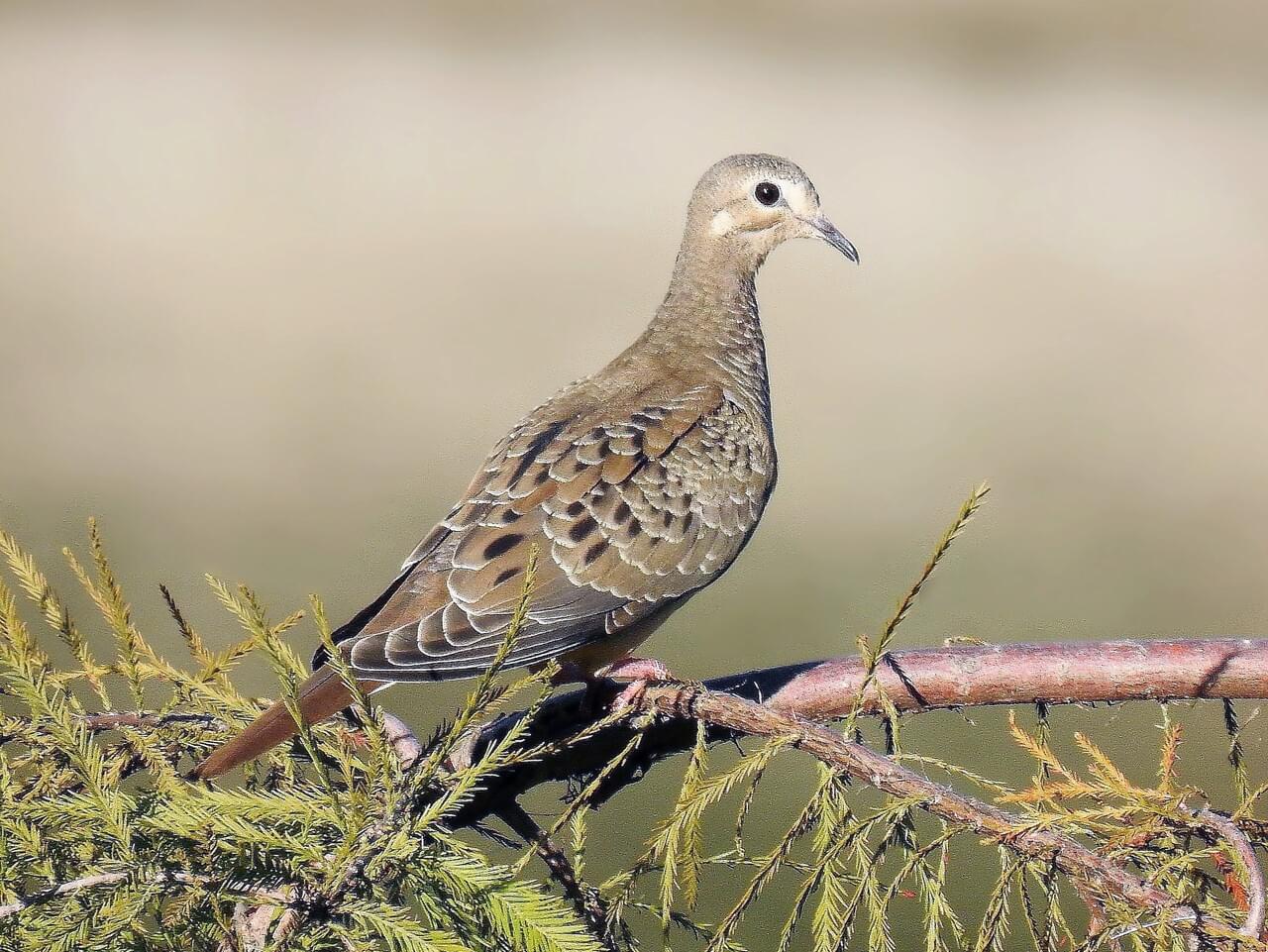

Here is a sound clip of a mourning dove: https://www.youtube.com/watch?v=1N9nMkZt1l0
Mourning Dove
This is a very common bird in the midwest with lovely cooing sounds. We find them often early in the morning under our bushes looking for food. They tend to stay out of the hot sun in the afternoons. They are also known as the rain dove and in colonial times as the turtle dove. Doves are the most frequently hunted bird species in North America (wahhh!) with 20 million being killed each year. Still, it's population numbers about 3.5 million.
Mourning doves can survive in desert areas because they can drink brackish water, up to 50% salinity. The eat mostly grains and grass seeds.


Here is a sound clip of a mourning dove: https://www.youtube.com/watch?v=1N9nMkZt1l0
16NorthernStar
I'll take May, then.
17John5918
For my Bird of the Month I choose the Dodo (Raphus cucullatus), an extinct flightless bird endemic to Mauritius, related to pigeons and doves. It's believed they were about a metre tall and weighed from 10 to 17 kg. It has been depicted with brownish-grey plumage, yellow feet, a tuft of tail feathers, a grey, naked head, and a black, yellow, and green beak. It used gizzard stones to help digest its food, which is thought to have included fruits, seeds, nuts and roots. It was flightless, and was well-adapted to its woody habitat and the absence of predators on the island. Unfortunately it was entirely fearless of humans and from around 1599 it was hunted by sailors and invasive species, its habitat was gradually degraded, and the last widely accepted sighting of one was in 1662. How little time it takes humans to destroy a whole species - a mere sixty years or so.
Just for the record, I've never seen one!

Dodo skeleton cast (left) and model based on modern research (right), at Oxford University Museum of Natural History.

Illustration of Dutch sailors pursuing dodos, by Walter Paget, 1914.
All from Wikipedia
Just for the record, I've never seen one!

Dodo skeleton cast (left) and model based on modern research (right), at Oxford University Museum of Natural History.

Illustration of Dutch sailors pursuing dodos, by Walter Paget, 1914.
All from Wikipedia
18Tess_W
>15 John5918: LOL I did? I think I posted in February and confused even myself!
19Tess_W
>17 John5918: Love it!
20NorthernStar
For May I have chosen a new-to-me bird I was fortunate to see on my March trip to the big island of Hawaii. The Nene (Branta sandvicensis) or Hawaiian Goose is the state bird of Hawaii, and endemic to the islands. The nene is found in the wild on the islands of Oahu, Maui, Kauaʻi, Molokai, and Hawaiʻi. It is listed as "near threatened." Predators include introduced pigs, mongoose, and feral cats. Although they do fly, they spend most of their time on the ground. There are "Nene Crossing" signs all over the island, but to my frustration, I hadn't had so much as a glimpse until a few days before we left. We finally saw a small flock one evening, eating grass near a pond near where we were going for dinner. Apparently golf courses are one of the best places to see them, but I'm not a golfer. The pictures I took are not great, as the light was going, so I've used a picture off the internet. The name is pronounced with two syllables, like nay-nay. Males and females have similar colouring.

Picture By Jörg Hempel - Own work, CC BY-SA 3.0 de, https://commons.wikimedia.org/w/index.php?curid=45026917

Picture By Jörg Hempel - Own work, CC BY-SA 3.0 de, https://commons.wikimedia.org/w/index.php?curid=45026917
22Tess_W
>20 NorthernStar: Nice one!
23John5918
I was all excited and ready to post Bird of the Month when I realised it's not my turn! Tess, I think you're up this month. I'll do next month, although you'll have to wait until the middle of the month as I'll be travelling in early July, including a birding trip to Eswatini.
24Tess_W
This month's bird of the month is the Black-Billed Magpie.

The Black-billed Magpie is also known as the American Magpie. The are in the Corvid (crow) family and are a staple of the American west. They are known for their "bushel-basket" nests. They are huge!

Magpies feed on a wide variety of items including fruits, grains, ticks, and insects such as caterpillars, flies, beetles, and grasshoppers. They also will kill small mammals such as mice, voles, and squirrels along with raiding birds’ nests. Carrion is another important food source. (they especially like the fly maggots!) They prefer open spaces, specifically telephone lines, fence posts, etc.
Amongst farmers there was a massive extermination program that took place in the 1920's & 1930's. It was believed that these birds killed livestock. That is not the case; although they will eat them once dead. This belief came from the fact that the magpies like to sit on the back of horses, cows, and sheep. They actually do this and then eat parasites that are crawling around on the animal, especially ticks. It has been known to happen that the bird will pick at sores in the flesh of freshly shorn sheep causing an infection. This bird dwindled in number until it was placed under protection in 1982 with the Migratory Bird Act.
These birds are then bane of vegetable and fruit gardeners; however no more so than raccoons, rabbits, or squirrels. In some nests watches, keys, marbles, coins, and other items have been found--they seem to like the shiny bling!
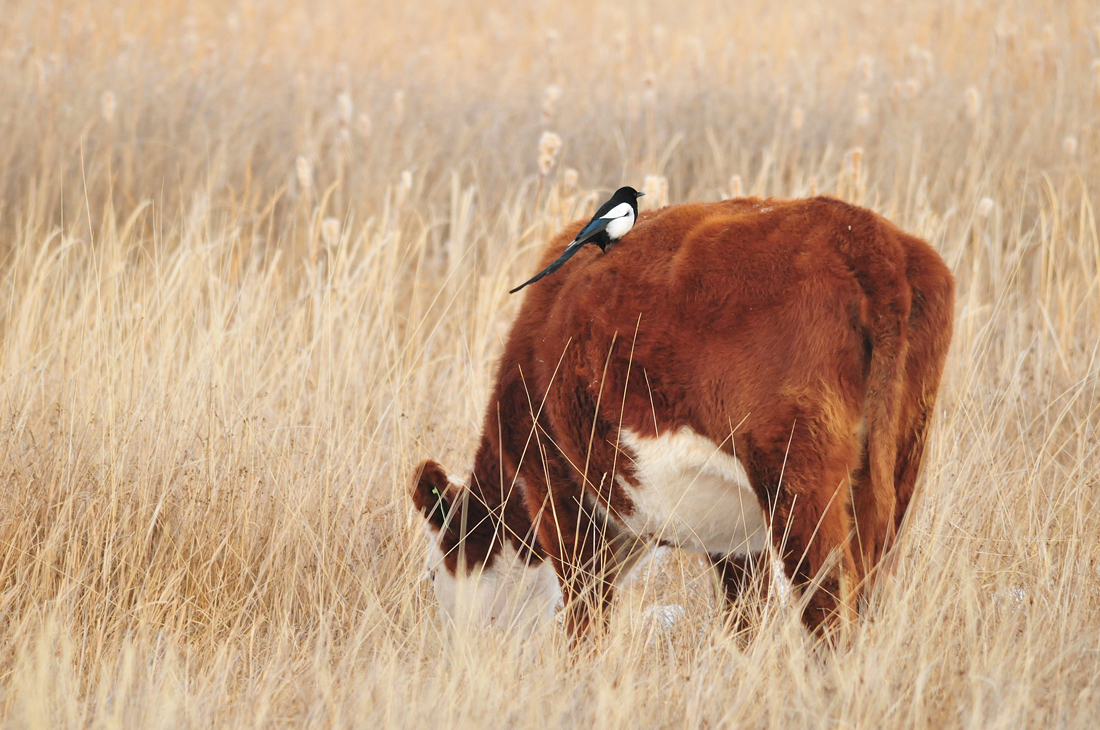



The Black-billed Magpie is also known as the American Magpie. The are in the Corvid (crow) family and are a staple of the American west. They are known for their "bushel-basket" nests. They are huge!

Magpies feed on a wide variety of items including fruits, grains, ticks, and insects such as caterpillars, flies, beetles, and grasshoppers. They also will kill small mammals such as mice, voles, and squirrels along with raiding birds’ nests. Carrion is another important food source. (they especially like the fly maggots!) They prefer open spaces, specifically telephone lines, fence posts, etc.
Amongst farmers there was a massive extermination program that took place in the 1920's & 1930's. It was believed that these birds killed livestock. That is not the case; although they will eat them once dead. This belief came from the fact that the magpies like to sit on the back of horses, cows, and sheep. They actually do this and then eat parasites that are crawling around on the animal, especially ticks. It has been known to happen that the bird will pick at sores in the flesh of freshly shorn sheep causing an infection. This bird dwindled in number until it was placed under protection in 1982 with the Migratory Bird Act.
These birds are then bane of vegetable and fruit gardeners; however no more so than raccoons, rabbits, or squirrels. In some nests watches, keys, marbles, coins, and other items have been found--they seem to like the shiny bling!




25John5918
>24 Tess_W:
Thanks, Tess. I love magpies, more so because we don't have them here. Whenever I'm in Europe I always look out for them, usually the common variety, although when I was on the Camino I was able to see the Iberian magpie.
Sitting on the backs of animals and eating insects reminds me of the oxpeckers which we have here. You'll see them on the backs of both domestic and wild animals.
Thanks, Tess. I love magpies, more so because we don't have them here. Whenever I'm in Europe I always look out for them, usually the common variety, although when I was on the Camino I was able to see the Iberian magpie.
Sitting on the backs of animals and eating insects reminds me of the oxpeckers which we have here. You'll see them on the backs of both domestic and wild animals.
26NorthernStar
>24 Tess_W: I love magpies. I grew up in Edmonton, Alberta, and they are very common there. We do see them occasionally here, and more often the last several years, but they are not common. Many birders dislike them because they raid other bird nests, but they have their place in nature and are part of the ecosystem. I vividly remember a childhood visit to an aviary in Hamilton, Ontario, where there were magpies in captivity. It seemed so strange, but they don't naturally live there.
27John5918
It's nearly July and I'm going to post the July Bird of the Month a few days early as I'm heading off to South Africa and Eswatini tomorrow for two or three weeks, which will include a weekend birdwatching at Phophonyane Falls Ecolodge, Piggs Peak. It's a superb forest environment. We had an enjoyable weekend there about fifteen years ago before I was a birdwatcher, and I'm really looking forward to going there again now with 'noculars and my copy of Roberts Birds of Southern Africa.
My July Bird of the Month is the Rosy-patched bushshrike, Rhodophoneus cruentus. In April we were driving home from a lodge about halfway between Mombasa and Nairobi. We'd just been stopped by a pair of policemen who were objecting to a small crack in the rear window of my ancient Land Rover and who were no doubt hoping to extort some cash from us until my wife threatened to phone a judge whom we know to establish that having a cracked rear window is not a motoring offence, and when they reluctantly got into their car and drove off we decided to pull off the road to eat our lunch to give them time to get well clear. As we were munching away on our samosas, she spotted a bird on a bush a few metres away which we had never seen before. On our first trawl through the bird book that we had with us we couldn't find it, but she persevered, and second time round we positively identified it.
This bushshrike is found in East Africa and the Horn of Africa in subtropical or tropical dry shrubland and savanna at altitudes between about 150 and 1,600 metres. Its conservation status is "Least Concern". A very distinctive feature is the bright red stripe from the throat down the breast. As we struggled to find the bird in the book we mused on whether we were simply seeing a bird with a throat wound bleeding profusely! There are two variants. Both have the striking red stripe, but south of the equator cathemagmena also has a black patch on the throat, while to the north, hilgerti doesn't.The one we saw was the northern variety with no black patch, as in the two photos below.


Images from Wikipedia and African Bird Club, information from Wikipedia, eBird and Terry Stevenson's Birds of East Africa.
And let me repeat my perennial invitation for volunteers to do Bird of the Month from time to time. If you're interested, please contact me or Tess here or by private message.
My July Bird of the Month is the Rosy-patched bushshrike, Rhodophoneus cruentus. In April we were driving home from a lodge about halfway between Mombasa and Nairobi. We'd just been stopped by a pair of policemen who were objecting to a small crack in the rear window of my ancient Land Rover and who were no doubt hoping to extort some cash from us until my wife threatened to phone a judge whom we know to establish that having a cracked rear window is not a motoring offence, and when they reluctantly got into their car and drove off we decided to pull off the road to eat our lunch to give them time to get well clear. As we were munching away on our samosas, she spotted a bird on a bush a few metres away which we had never seen before. On our first trawl through the bird book that we had with us we couldn't find it, but she persevered, and second time round we positively identified it.
This bushshrike is found in East Africa and the Horn of Africa in subtropical or tropical dry shrubland and savanna at altitudes between about 150 and 1,600 metres. Its conservation status is "Least Concern". A very distinctive feature is the bright red stripe from the throat down the breast. As we struggled to find the bird in the book we mused on whether we were simply seeing a bird with a throat wound bleeding profusely! There are two variants. Both have the striking red stripe, but south of the equator cathemagmena also has a black patch on the throat, while to the north, hilgerti doesn't.The one we saw was the northern variety with no black patch, as in the two photos below.


Images from Wikipedia and African Bird Club, information from Wikipedia, eBird and Terry Stevenson's Birds of East Africa.
And let me repeat my perennial invitation for volunteers to do Bird of the Month from time to time. If you're interested, please contact me or Tess here or by private message.
28NorthernStar
>27 John5918: Very cool bird. Thank you for another interesting entry!
I assume I am up again for August, unless someone else volunteers to try a month.
I assume I am up again for August, unless someone else volunteers to try a month.
29Tess_W
>27 John5918: Very nice! (Both the story, bird, and pic!)
30NorthernStar
For August's bird I have chosen a very handsome bird I usually only see in the spring (if I'm lucky), but several of which showed up in my yard last week. The Rose-breasted Grosbeak male has gorgeous plumage in black, white, and red. The females are a lovely streaky mix of browns and white. The Rose-breasted Grosbeak is a large finch and true to their name have a very large bill. The large, pale, triangular bill is a good identifying mark, especially to distinguish the females. They eat a lot of insects as well as wild fruits, berries, and seeds.
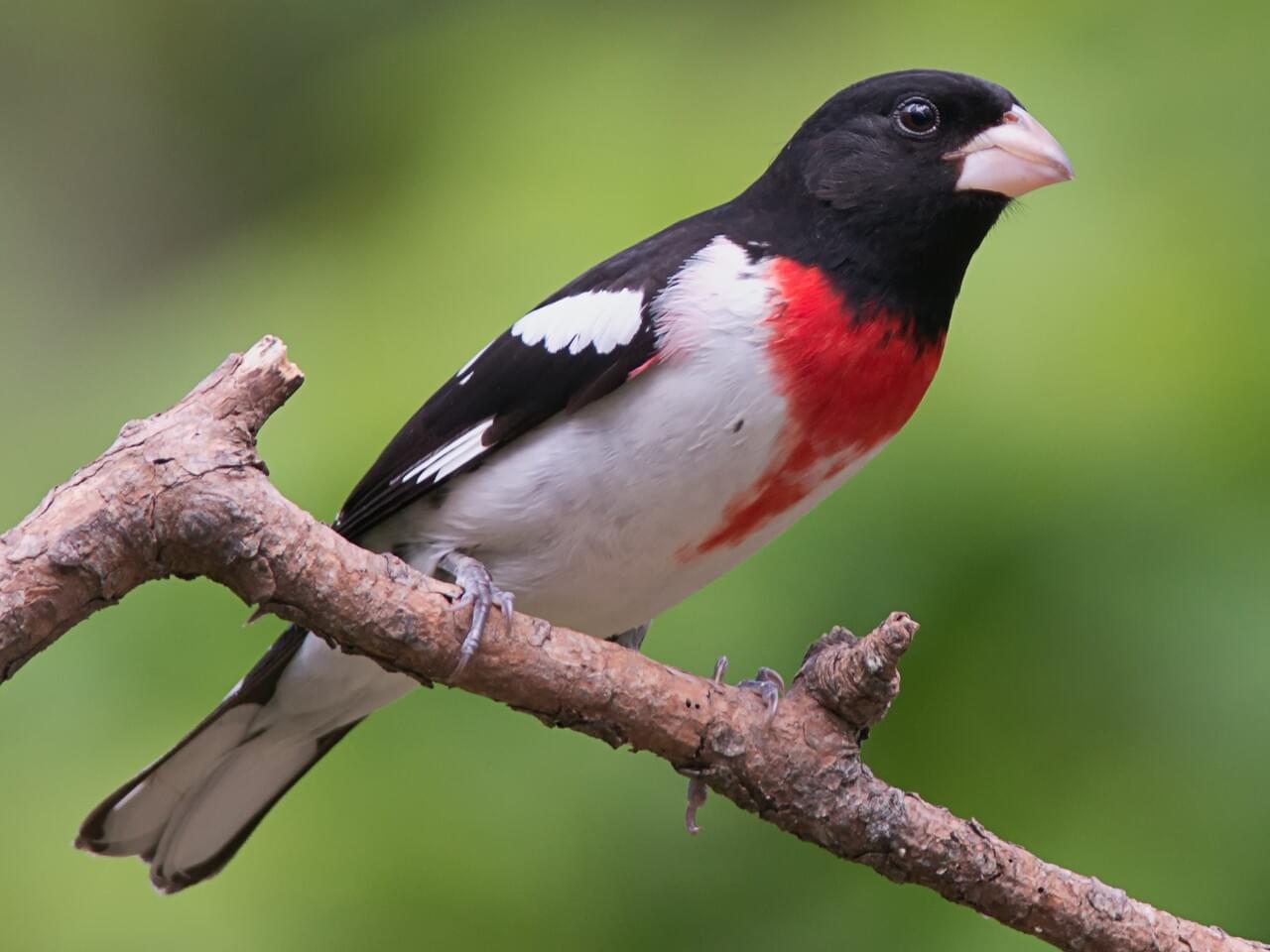
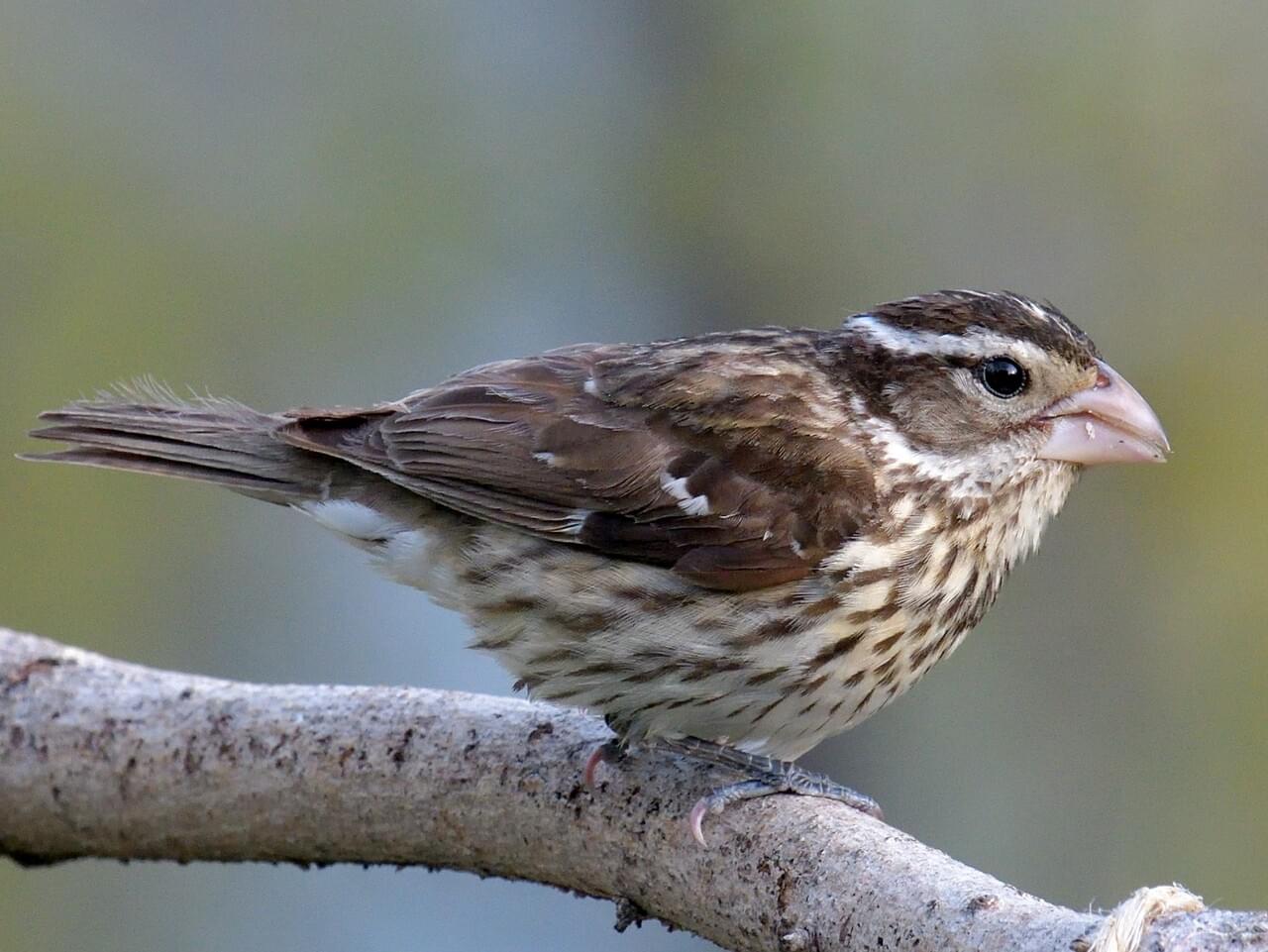
male on the left and female on the right
Range map - Rose-breasted Grosbeaks breed in North America, and winter in Central and South America. I am near the farthest northwest extent of their range.

Pictures and map from All About Birds. For more information: https://www.allaboutbirds.org/guide/Rose-breasted_Grosbeak


male on the left and female on the right
Range map - Rose-breasted Grosbeaks breed in North America, and winter in Central and South America. I am near the farthest northwest extent of their range.

Pictures and map from All About Birds. For more information: https://www.allaboutbirds.org/guide/Rose-breasted_Grosbeak
31John5918
>30 NorthernStar: What a beautiful bird!
32Tess_W
>30 NorthernStar: Beautiful bird! There is such a striking difference between the male and female. I may have seen a male now and then, however, the female is so indistinct that I would not give it a good second look thinking it was a sparrow or a wren.
33clamairy
>30 NorthernStar: I love these birds, but I have not seen one since I moved from Connecticut to the Eastern end of Long Island. I know they are here because I see other people in the LI bird group on Facebook sharing photos. They just don't come to my feeders. :o(
34Tess_W
September's Bird of the Month is the American Goldfinch. I have seen this bird many times in my yard this year. They generally hang around in or on the shrubbery and fly away when they are startled. I've found no nests. Until doing this research I was unaware the the breeding males and non-breeding males are differently colored.
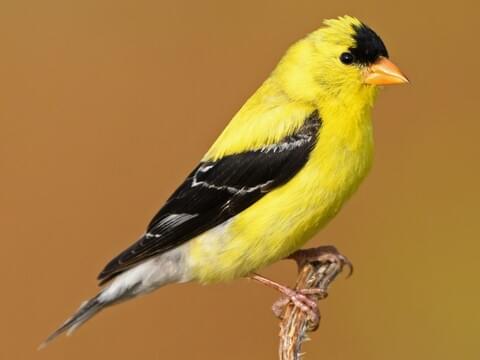

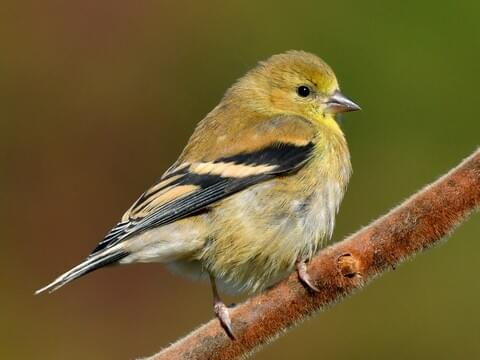 female
female
After about 18-24 months the non-breeding males will molt and become brightly colored to attract the females.
Here is a sound clip of the American goldfinch: https://www.youtube.com/watch?v=2QqAhz2-vcc
The American Goldfinch is about the size of a sparrow. According to several sources their numbers might be declining slightly as they prefer to live in meadows, which are in decline. They prefer to eat mainly seeds, with daisies and thistles being on the top of their list. They also feed on maple sap and will digest insects that are on greens that they eat. Females usually lay 4-6 eggs and incubate them 12-24 days depending upon the air temperature. The male feeds the female while she incubates. Both parents feed the young which leave the nest at 11-17 days.
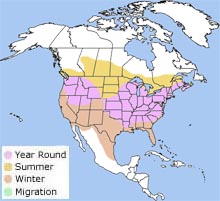


 female
femaleAfter about 18-24 months the non-breeding males will molt and become brightly colored to attract the females.
Here is a sound clip of the American goldfinch: https://www.youtube.com/watch?v=2QqAhz2-vcc
The American Goldfinch is about the size of a sparrow. According to several sources their numbers might be declining slightly as they prefer to live in meadows, which are in decline. They prefer to eat mainly seeds, with daisies and thistles being on the top of their list. They also feed on maple sap and will digest insects that are on greens that they eat. Females usually lay 4-6 eggs and incubate them 12-24 days depending upon the air temperature. The male feeds the female while she incubates. Both parents feed the young which leave the nest at 11-17 days.

35John5918
I think it's my turn to do Bird of the Month, with my usual call for volunteers. Anyone who is interested in taking a turn, please contact Tess or myself either here on by private message.
This month let me highlight the Narina trogon (Apaloderma narina), if only because it is such an unusual name! It's a very beautiful green and red bird with a yellow bill, a little over 30cm long. Males are brighter coloured than females. Although its conservation status is "Least Concern" and it has a large range in Africa, inhabiting lowland to highland, valley and riparian forests, woodlands and plantations, from tropical to temperate regions, it is quite difficult to see as it likes thick forests. The diet consists mainly of insects and small invertebrates as well as rodents and small reptiles. The royal family of eSwatini traditionally wear red feathers, and I'm told the Narina trogon is one of the birds from which they obtain them.
I first came across this bird in 2020 in the Arabuko-Sokoke Forest Reserve on the Kenyan coast. It was identified for us by its call by a Kenya Forestry Service bird guide, but we never actually saw it in the dense forest. In July of this year we were at Phophonyane Falls in eSwatini and we were very hopeful of seeing one as they are abundant in that forest reserve, but by the end of the weekend we had not seen one. At breakfast on our last morning we were chatting to the owner of the lodge, himself an acknowledged bird expert, and he said, "Oh, but I saw one outside my bedroom window just this morning!" As he finished his breakfast he wandered out of the dining room, and immediately hurried back in to tell us there was one just outside, visible from the veranda. We rushed out, and sure enough, there it was, sitting on a branch maybe ten metres away. We had a clear view of it with the naked eye as well as the 'noculars, and it remained there for several minutes. A real treat to end a lovely weekend.

Photo from Wikipedia, although it's a very similar setting to what we saw, as described above!
This month let me highlight the Narina trogon (Apaloderma narina), if only because it is such an unusual name! It's a very beautiful green and red bird with a yellow bill, a little over 30cm long. Males are brighter coloured than females. Although its conservation status is "Least Concern" and it has a large range in Africa, inhabiting lowland to highland, valley and riparian forests, woodlands and plantations, from tropical to temperate regions, it is quite difficult to see as it likes thick forests. The diet consists mainly of insects and small invertebrates as well as rodents and small reptiles. The royal family of eSwatini traditionally wear red feathers, and I'm told the Narina trogon is one of the birds from which they obtain them.
I first came across this bird in 2020 in the Arabuko-Sokoke Forest Reserve on the Kenyan coast. It was identified for us by its call by a Kenya Forestry Service bird guide, but we never actually saw it in the dense forest. In July of this year we were at Phophonyane Falls in eSwatini and we were very hopeful of seeing one as they are abundant in that forest reserve, but by the end of the weekend we had not seen one. At breakfast on our last morning we were chatting to the owner of the lodge, himself an acknowledged bird expert, and he said, "Oh, but I saw one outside my bedroom window just this morning!" As he finished his breakfast he wandered out of the dining room, and immediately hurried back in to tell us there was one just outside, visible from the veranda. We rushed out, and sure enough, there it was, sitting on a branch maybe ten metres away. We had a clear view of it with the naked eye as well as the 'noculars, and it remained there for several minutes. A real treat to end a lovely weekend.

Photo from Wikipedia, although it's a very similar setting to what we saw, as described above!
36TempleCat
>35 John5918: Pretty bird, but its beak looks like it could crush bone!
37NorthernStar
>34 Tess_W:, >35 John5918: Thank you! Both are beautiful birds.
38NorthernStar
It's November 1, and I believe I am up for November's bird of the month!
For this month I am choosing another iconic boreal bird - the Great Grey Owl, Strix nebulosa. This is North America's largest owl, up to 85cm (33 in) tall, and with a wingspan of up to 150cm (60 in). Despite this, it is outweighed by both the Great Horned and Snowy Owls, which also have larger feet and talons. This means it is mostly feathers - only weighing in at just over 1 kg or 2.5 lb. It is found in the N. American boreal forest from Alaska to Quebec, and further south in the western mountains, as well as in Scandinavia, Russia, Siberia, and Mongolia. Like many other northern birds, they do have occasional irruptions when they are found much further south than their usual range.
Despite its size, it is rarely seen: partly because of where they live, and partly because they are very hard to spot. They tend to sit still at the edge of a meadow or opening listening for prey, and their camouflaged colouration means they look more like a decaying stump than a bird. I have been lucky enough to see one a few times, but must have passed by many others that I never saw.
Like several other owls, they can locate their prey by the faintest sounds, and accurately target them even through deep snow. They eat mainly mice, voles, and other small mammals.



Photos and information from All About Birds, https://www.allaboutbirds.org/guide/Great_Gray_Owl/overview
For this month I am choosing another iconic boreal bird - the Great Grey Owl, Strix nebulosa. This is North America's largest owl, up to 85cm (33 in) tall, and with a wingspan of up to 150cm (60 in). Despite this, it is outweighed by both the Great Horned and Snowy Owls, which also have larger feet and talons. This means it is mostly feathers - only weighing in at just over 1 kg or 2.5 lb. It is found in the N. American boreal forest from Alaska to Quebec, and further south in the western mountains, as well as in Scandinavia, Russia, Siberia, and Mongolia. Like many other northern birds, they do have occasional irruptions when they are found much further south than their usual range.
Despite its size, it is rarely seen: partly because of where they live, and partly because they are very hard to spot. They tend to sit still at the edge of a meadow or opening listening for prey, and their camouflaged colouration means they look more like a decaying stump than a bird. I have been lucky enough to see one a few times, but must have passed by many others that I never saw.
Like several other owls, they can locate their prey by the faintest sounds, and accurately target them even through deep snow. They eat mainly mice, voles, and other small mammals.



Photos and information from All About Birds, https://www.allaboutbirds.org/guide/Great_Gray_Owl/overview
39TempleCat
>38 NorthernStar: I saw one of those once in Massachusetts, but only because three crows were having a conniption fit over it being in their territory. They harassed and dive-bombed it until it left, but that's what focussed my attention on it. It was just a part of the tree up to that point.
41lorax
I've always wanted to see one of those! I've been fortunate enough to see a Snowy Owl, but they're more prone to wandering south of their normal range, and I haven't yet ventured to northern Minnesota (despite invitations from my sister-in-law) in winter to try to spot a Great Gray. (Should have gone to the high Sierras when I lived in California!)
42Tess_W
December's Bird is the American Woodcock. I saw this bird 2-3 months ago, did not recognize it and had to look it up. My initial description was a "somewhat" coloring like a sparrow and a very long beak, found at the entrance to a wooded trail. That with the location took me instantly (ebird) to the American Woodcock. I did not see this bird fly as it disappeared before I could follow it.
The American Woodcock would find brown leaves to be their best friend when trying to hide. Their favorite diet staple is worms and as one can tell, they have the bill to peck in the damp floors of the forest for their meal. Wikipedia says the woodcock is a shore bird, but Ebird did not mention that and I definitely did not find it near anything larger than a mud puddle.
Per Ebird, in the spring the males perform quit a dance that includes diving and vocalizations. The young birds leave the nest 2-3 hours after birth, but mom does feed them for a week until they figure out the whole bill/earth/worm thing.

The American Woodcock is the only Woodcock found in North America. It's population has declined 1% per year since the 1960's due to deforestation and urbanization. There is currently a conservation program being put into place for the Woodcock. The Woodcock is a popular gamebird and hunters kill about 135,000 per year. Upon research, it appears Woodcock is a delicacy, surpassing duck and pheasant.
Popular nicknames for the American Woodcock is the timberdoodle, bogsucker, and Labrador whistler.

Some great pictures of the woodcock family as well as their moves can be found here: https://khak.com/american-woodcock-dancing-video/
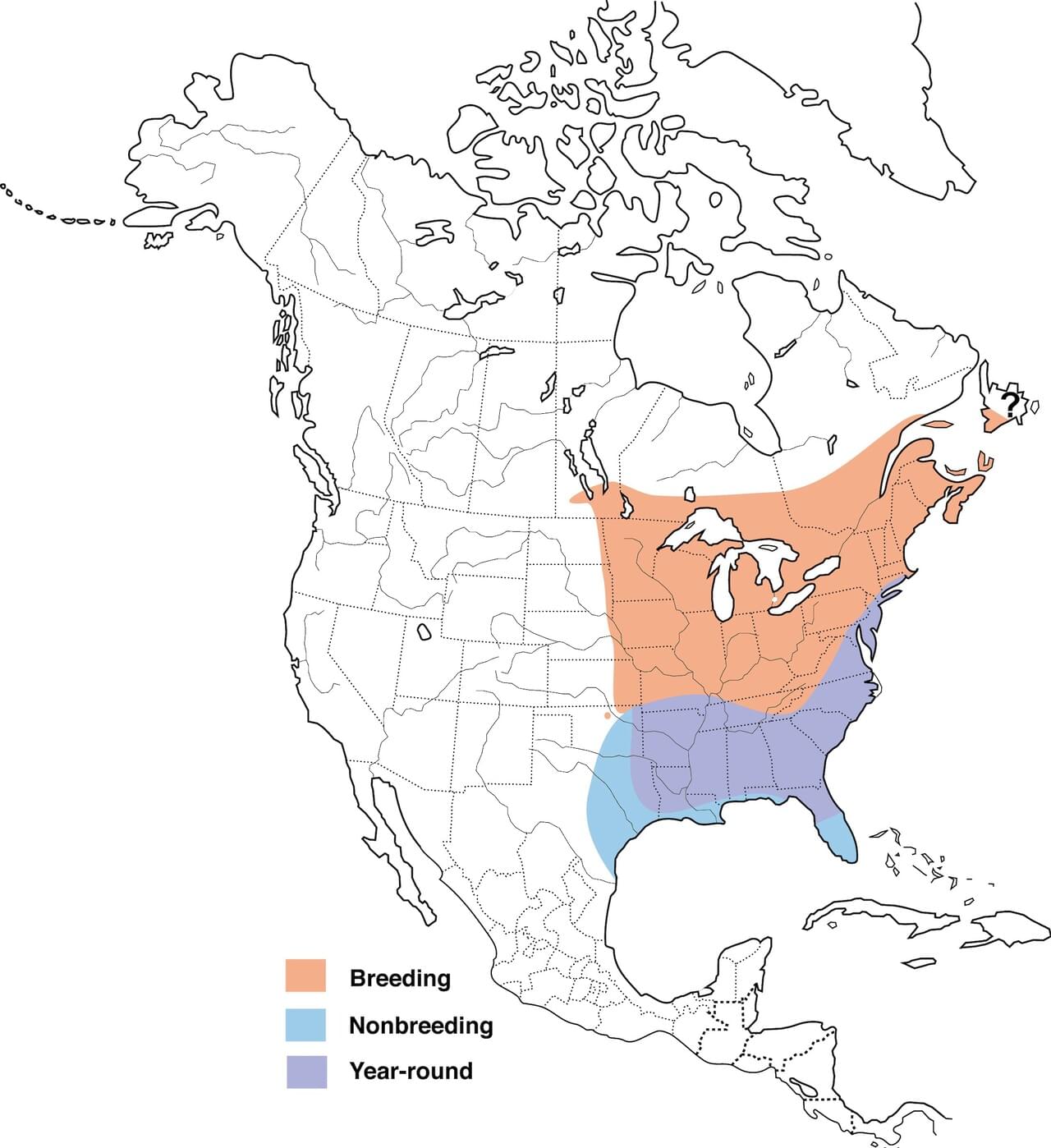
May your holidays be blessed!
The American Woodcock would find brown leaves to be their best friend when trying to hide. Their favorite diet staple is worms and as one can tell, they have the bill to peck in the damp floors of the forest for their meal. Wikipedia says the woodcock is a shore bird, but Ebird did not mention that and I definitely did not find it near anything larger than a mud puddle.
Per Ebird, in the spring the males perform quit a dance that includes diving and vocalizations. The young birds leave the nest 2-3 hours after birth, but mom does feed them for a week until they figure out the whole bill/earth/worm thing.
The American Woodcock is the only Woodcock found in North America. It's population has declined 1% per year since the 1960's due to deforestation and urbanization. There is currently a conservation program being put into place for the Woodcock. The Woodcock is a popular gamebird and hunters kill about 135,000 per year. Upon research, it appears Woodcock is a delicacy, surpassing duck and pheasant.
Popular nicknames for the American Woodcock is the timberdoodle, bogsucker, and Labrador whistler.

Some great pictures of the woodcock family as well as their moves can be found here: https://khak.com/american-woodcock-dancing-video/

May your holidays be blessed!
43NorthernStar
>42 Tess_W: Thank you, that is a fascinating bird, it reminds me a bit of a snipe.
44TempleCat
>42 Tess_W: I love those pictures! I'm trying to memorize what that bird looks like should I get to see one. The best I can come up with is a mottled black and brown extra-large egg with a stubby head and short streamlined tail stuck on either end, no neck, and wielding a long sword (epee, to be more precise.) I know they're found in my neck of the woods, so maybe I'll get lucky. 🤞
45Tess_W
>44 TempleCat: I also read that it is the bird that has its eyes farthest from the center of its head, or more on the side of the head than any other bird. Great peripheral vision!
46John5918
>45 Tess_W:
I was visiting friends in UK last month who kept a parrot in a cage (not something I approve of!) and it struck me how it had to turn its head to look at me, as its eyes were almost diametrically opposite each other on each side of its head. It appeared to have very little forward vision unlike, for example, an owl which has forward facing eyes. I suppose birds of prey need good forward 3D vision for hunting, while birds like a parrot or woodcock need all round peripheral vision to watch out for predators.
I was visiting friends in UK last month who kept a parrot in a cage (not something I approve of!) and it struck me how it had to turn its head to look at me, as its eyes were almost diametrically opposite each other on each side of its head. It appeared to have very little forward vision unlike, for example, an owl which has forward facing eyes. I suppose birds of prey need good forward 3D vision for hunting, while birds like a parrot or woodcock need all round peripheral vision to watch out for predators.
47TempleCat
>45 Tess_W: Ah, good point! Thanks!

